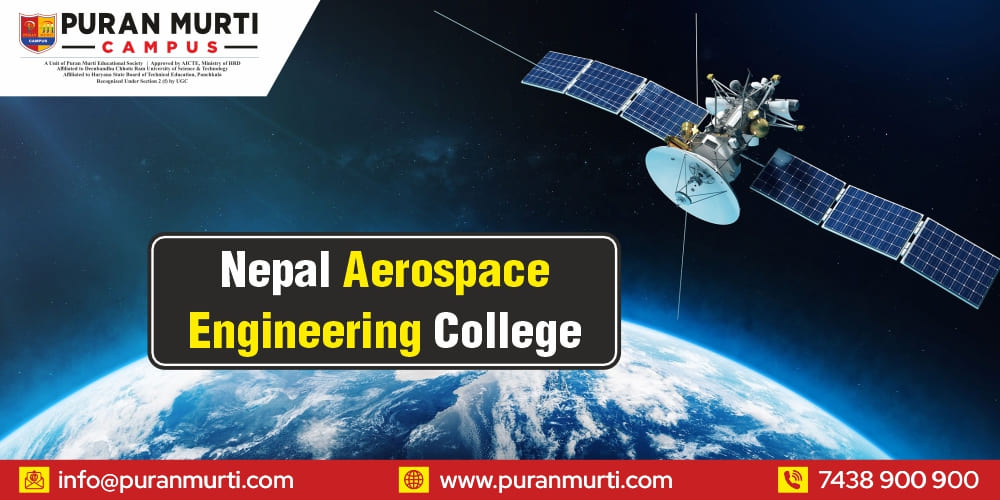Nepal Aerospace Engineering College
Posted on : 12 November, 2025 4:34 pm
Thinking about studying aerospace engineering in Nepal? Excellent choice. Nepal’s aerospace and aeronautical education is growing, and students who choose this path often combine strong theoretical training with hands-on practice. In this blog I’ll walk you through what to expect from an aerospace engineering program in Nepal, using Puran Murti Campus as a reference point to illustrate facilities, curriculum, student life and career pathways. The tone here is warm and practical think of this as a friendly senior-student guide. Here is the Nepal Aerospace Engineering College.
What is the benefit of studying aerospace engineering in Nepal?
- Expanding field: Aviation, drone technology, avionics, and other industries are growing around the world — and so is Nepal as it develops education and training programs to meet that demand.
- Tight community: Programs in Nepal often have smaller cohorts than large international universities – this means you may develop stronger relationships with faculty and peers, with more one-on-one connection.
- Real-world benefits: Many campuses are more focused than international campuses on real-world skills including basic aircraft maintenance, avionics, and UAV/drone operation – all employable skills right away. Apply Now
Snapshot: Puran Murti Campus (used here as a reference)
You asked for Puran Murti Campus to be taken as a reference so throughout this post I’ll use it as an example of what a well-organized Nepalese aerospace engineering campus might offer. When thinking about any campus, look for these markers: Apply Now
- Clear program structure: Semester-wise course outlines, core vs elective courses, and visible learning outcomes.
- Exemplifying classroom instruction with practical labs and workshops, examples would be avionics labs, materials labs, wind-tunnel or simulation labs (and/or access to simulation software), and workshop spaces designed for fabrication and maintenance practice.
- Industry connections or opportunities for internships with airlines, MRO (maintenance, repair and overhaul) facilities, aviation authorities or drone companies.
- Support services: Career counselling, alumni networks, and soft-skills training (communication, project management, safety culture). Apply Now
Common program structure and core topics Apply Now
Most undergraduate (bachelor’s degree) programs in aerospace or aeronautical engineering in Nepal (and similar regions) follow a structure that balances fundamentals and specialization: Apply Now
1–2 Year (Foundation)
- Maths, Physics, Engineering Drawing
- Basic electrical and electronic engineering
- Introduction to materials and manufacturing
3 Year (Core aerospace concepts)
- Aerodynamics and fluid mechanics
- Aircraft structures / materials
- Principles of propulsion
- Flight mechanics / stability
4 Year (Advanced & capstone)
- Avionics & instrumentation
- Aircraft systems & maintenance practices
- UAV / drone design and applications
- Final year project or capstone (linked to industry if possible)
Many campuses have lab courses and simulated projects throughout the degree. Apply Now
Facilities to look for (puran murti campus as a checklist)
When evaluating the colleges, check if they have – or have access to – the following facilities: Apply Now
- Electronics and avionics lab (e.g. oscilloscopes, signal generators, microcontrollers)
- Materials and structures workshop (e.g. composites, metal working equipment)
- Flight / control simulators or strong software simulation capability (e.g. MATLAB/ Simulink, ANSYS, XFLR5, X-Plane)
- UAV / drone lab – used for designs, testing, field flights
- Library with industry standards & regulations (e.g. ICAO, Aeronautical standards, maintenance manuals)
- Connections with local airports or maintenance facilities for hands on exposure Apply Now
Eligibility & Admission (general guidance)
Each institution sets its own admission criteria, but the common prerequisites are: Apply Now
- Completion of +2 or equivalent with significant knowledge of physics, mathematics and English.
- Some colleges will also have an entrance test or interview
- Minimum marks, based on each campus.
If you come from outside of Kathmandu or a different educational board, you should contact the admissions office for information on equivalency and the format of acceptable documentation. Apply Now
Career paths & job prospects
- Aircraft maintenance and repair (AMO/MRO) – technicians and engineers employed by airlines and aircraft maintenance workshops.
- Avionics and embedded systems – working on aircraft instruments and control and even navigation systems.
- Unmanned Aerial Vehicles (UAVs/drones) – design and operation as well as service position in mapping, surveying, agriculture, etc.
- Regulatory and safety positions – working in regulatory agencies or civil aviation authorities, and airport operations.
- Further studies and research – completing master’s degrees in yet another country or in fields of specialization, such as aero-structures, propulsion, or aerospace control systems. Apply Now
Engagement through practical internships or a capstone project will certainly enhance your marketability. Apply Now
Student life & campus culture
Expect a mix of academic focus and hands-on clubs. Popular student activities include: Apply Now
- Aero clubs or UAV/drone teams
- Workshops and hands-on training camps
- Industrial visits to airports and workshops
- Soft-skill workshops: technical writing, presentation, safety training
- Because cohorts are often smaller, forming project teams and finding peer mentors is easier — a real advantage. Apply Now
Advice for prospective students
- Look for relevant experience: Be sure to aim for colleges that involve students in workshops, internships or labs, and not just classroom theory.
- Build your programming & electronics capabilities early on: A basic knowledge of microcontrollers (Arduino/STM32) and MATLAB will give you a head start.
- Participate in clubs and competitions: Drone challenges, design competitions or hackathons will give your CV strong credibility and experience.
- Get engaged in internships, preferably unpaid: Better to see real life use than be just credentialed in the classroom.
- Network with alumni and faculty: They tend to know of student internships or job opportunities after graduation.
Final thoughts
Aerospace engineering in Nepal is a promising path for students who enjoy physics, design, and hands-on building. Using Puran Murti Campus as a touchstone, look for institutions that blend strong fundamentals with real-world labs, industry connections, and active student communities. If you pair your degree with practical projects especially in UAVs, avionics, or maintenance you’ll be well-positioned for both local and international opportunities. Apply Now



